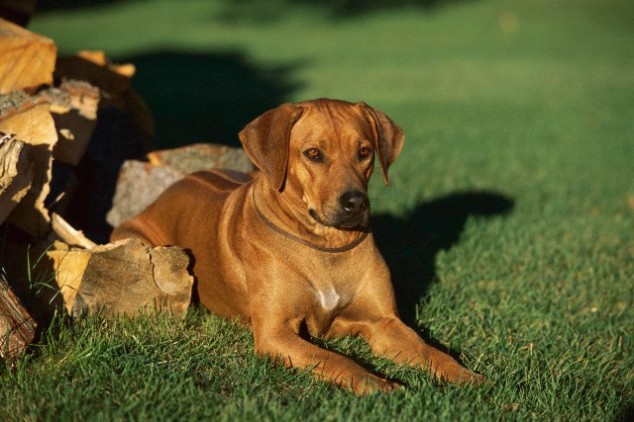
Description: The Rhodesian Ridgeback, also known as a lion dog, is a large, athletic, and fairly muscular dog. It gets its name from the distinct ridge-like appearance over the length of the spine due to a narrow strip of fur growing in the opposite direction of the rest of the fur. Other notable features include long, strait legs; a long tail, thick at the base which tapers to a point; a deep chest; a long muzzle; and medium sized ears which sit high on either side of the head.
The Rhodesian has a short, dense and shiny light brown colored coat. The nose is either liver or black and may possess a black melanistic mask. These dogs are average shedders and are relatively easy to groom.
History: The Hottentot people of South Africa owned a hunting dog which possessed a ridge of fur on its back. This dog bred with the dogs of the European settlers produced many varieties similar to the Rhodesian Ridgeback we know today. In the 1870’s many of these dogs were brought to Rhodesia (now, Zimbabwe) to hunt lions, which later earned their them the title of “lion dogs.” Packs of Ridgebacks would track lions by sight and scent. Once the Ridgebacks found a lion they would keep the lion at bay by barking and growling until the hunter could shoot the lion. In the 1920’s there were so many different varieties of ridgeback lion dogs, that a standard needed to be set. Dogs that met the specific requirements were deemed to be Rhodesian Ridgebacks.
Size: Males: 25-27 inches at the withers, weighing 80-90 pounds. Females: 24-26 inches at the withers, weighing 65-75 pounds.
Temperament: The Rhodesian Ridgeback has a lot of stamina and energy so, they demand a lot of exercise. This breed is a great jogging and even biking companion. Chances are you will get tired before the Rhodesian. Since these dogs were bred in Africa, they can perform high intensity activities in hot weather.
The Rhodesian Ridgeback isn’t probably the best choice for an inexperienced dog owner. The Ridgeback is very strong willed and demands a pack leader who can give firm redirection. That being said, if an owner punishes or yells at their Ridgeback, the dog will likely lose attention and ignore further corrective measures.
Ridgebacks are very protective of their owners but, if properly socialized and trained when young, can be welcoming of strangers.
Health: Like all deep chested dogs, the Rhodesian Ridgeback is susceptible to bloat. Hip dysplasia, caused by either poorly developed pelvic muscles or a femur which fits incorrectly into the pelvic socket, is a common condition among Ridgebacks. Another condition common to Ridgebacks is dermoid sinus which affects nearly 5% of Ridgebacks. A dermoid sinus is a congenital, tube-like structure which grows from the dogs spine outward to the skin, resembling a piece of spaghetti. On the surface, a dermoid sinus looks like a tiny hole in the skin. A dermoid sinus only becomes painful when it becomes infected. While all surgery has risks, fortunately, surgical removal of the dermoid sinus is relatively simple.
Lifespan: The Rhodesian has a lifespan of approximately 10-12 years.
Trivia: The misunderstanding exists that Rhodesian Ridgebacks were bred to kill lions; this is not true. Rhodesian Ridgebacks simply tracked lions and alerted the hunter that a lion was near.



